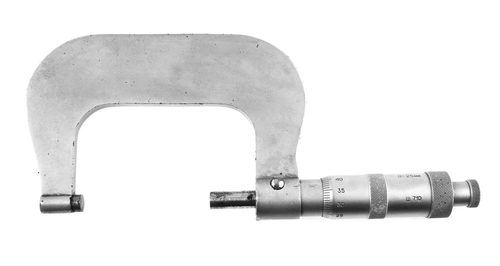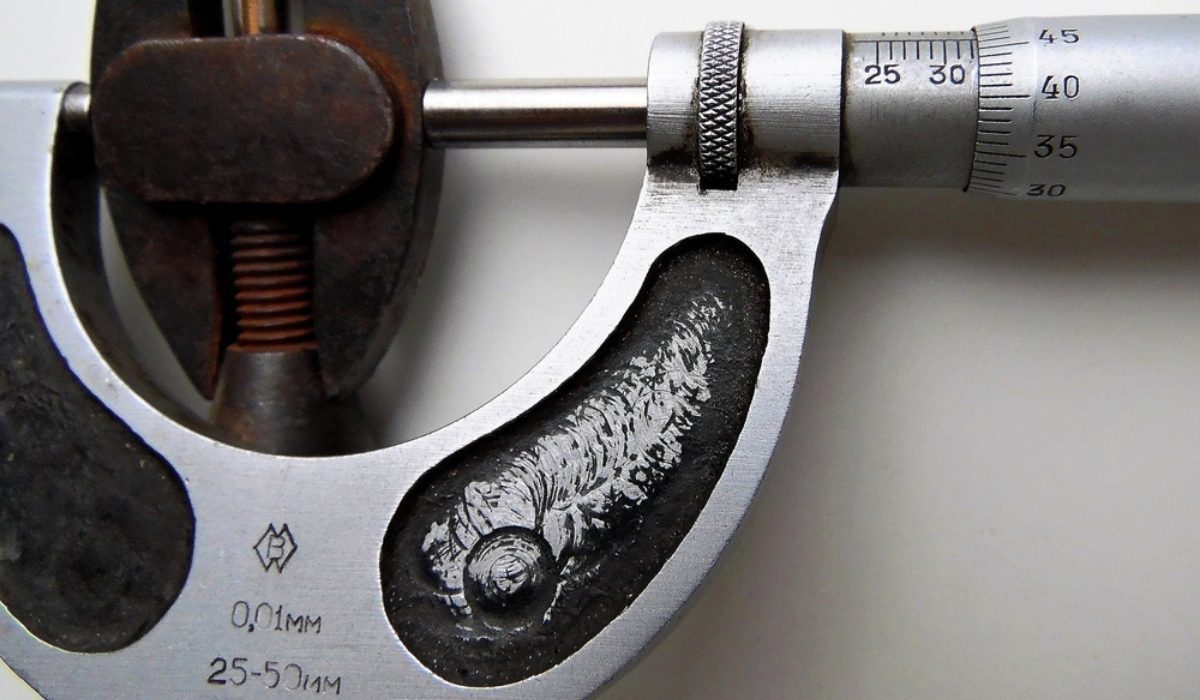Micrometre, also known as a screw gauge, is a precision measuring instrument used for measuring small dimensions accurately. It can measure lengths from a few millimetre to a few hundred millimetre. Micrometre readings are used in various industries, such as engineering, manufacturing, science and research, automotive industry and metrology.
See also: How to read callipers?

A step-by-step guide to read micrometre
Components of micrometre
- Frame: It is the main body of the micrometre, providing a base for the micrometre. It is usually made of durable materials like hardened steel.
- Anvil and spindle: They are the measuring surfaces of the micrometre. The anvil remains fixed while the spindle is moved towards or away from the anvil.
- Thimble: It is a spinning cover and allows the spindle to move in a controlled and accurate movement.
- Barrel or sleeve: It is a fixed part that connects the frame and has a scale with markings on it.
Understanding the markings
A micrometre has two scales, the sleeve scale and the thimble scale. The sleeve scale is fixed and has markings in millimetre (mm) and centimetre (cm). We can take additional measurements with a thimble scale, increasing by small units, usually in tenths or hundredths of millimetre (0.01mm or 0.001mm).
Prepare the micrometre
Before taking a micrometre reading, make sure that the micrometre is clean. Check that the measuring faces (anvil and spindle) are clean and free of debris or scratches that could impact the precision of the measurement. If required, clean the micrometre with a soft cloth. Ensure your fingers do not touch the measuring surfaces while holding the micrometre.
Using your thumb and index finger, rotate the thimble until the zero on the circular scale coincides with the main scale on the sleeve. Take note of the least count.
Place the object
Place the object to be measured between the anvil and the spindle, and make sure it is levelled and in contact with both the measuring surfaces (anvil and spindle). Close the spindle gently until it just touches the object. Too much force should be avoided as it may impact measurement accuracy.
Take the reading
Check the sleeve scale and write down the value displayed by the line or mark on the sleeve that corresponds to the reference line on the thimble scale.
Check the thimble scale line or mark that corresponds to the sleeve scale reference line. The additional measurement will be represented by this line.
Add both the values, i.e. sleeve scale value and the thimble scale value. This will provide you with the exact micrometre reading. Remember to take into account the thimble scale’s smaller increments.
The formula is mentioned below:
Total measurement = Sleeve scale reading + (thimble scale reading*least count)
Accurate micrometre readings require practice and patience. Take multiple measurements to ensure accuracy. Take an average of the results if you obtain different readings.
Ensuring accurate readings
- Calibration: Before using a micrometre, it is important to calibrate it, i.e. zeroing the instrument.
- Cleanliness: Make sure that both the micrometre measuring surfaces and the object being measured are clean and free of any debris. Dust or dirt can hinder measurement accuracy.
- Stability: Both the micrometre and the object being measured must be stable. If required, secure the micrometre using a sturdy surface. This helps to reduce any movement that can affect the measurement.
- Proper technique: Close the micrometre so that it only slightly touches the object being measured. Excessive force can cause the measurement to be distorted. For greater precision, take multiple measurements.
FAQs
How does a micrometre work?
The screw that is connected to the spindle, when rotated, causes the spindle to move either closer or farther away from the object being measured. This movement is carefully calibrated and can be read from the scale on the micrometre.
What are the different types of micrometres?
There are four types of micrometres, outside micrometres, inside micrometres, depth micrometres and digital micrometres.
How can I use a digital micrometre to take a reading?
Press the two hinges of the micrometre together until the object being measured is securely held. Check the measurement on the digital screen. The measurement will be displayed in the unit of measurement, either millimetres or inches.
How to set the micrometre's zero point?
Rotate the thimble until the spindle is close to the anvil but not touching it. Look at the barrel of the micrometre and locate the zero point. It should coincide with the zero on the rotating thimble.
What is least count?
The least count for a micrometre is determined by the screw pitch divided by the number of divisions on the thimble. It is usually indicated on the thimble.
Are there any precautions to take when using a micrometre?
Handle the micrometre carefully to avoid damaging its delicate measuring surfaces. When taking measurements, avoid applying excessive force. Protect your fingers by keeping them away from the moving parts. When not in use, keep the micrometre in a protective case.
| Got any questions or point of view on our article? We would love to hear from you. Write to our Editor-in-Chief Jhumur Ghosh at jhumur.ghosh1@housing.com |






